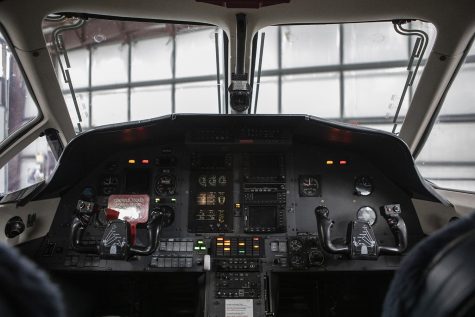New UIHC plane brings patients farther, faster
The newest addition to the hospital’s AirCare program will increase how quickly and effectively UIHC can treat patients throughout the state.
The new University of Iowa Hospitals AirCare plane rests in its hanger on Wednesday, February 20, 2019. This PC-12 was built by Swiss company Pilatus and boasts a Pratt and Whitney PT6 turboprop engine capable of producing over 1900 horsepower.
February 22, 2019
A pediatric patient in need of intensive care was flown to the University of Iowa Hospitals & Clinics on Feb. 15, but not by helicopter — by airplane.
The newest black-and-gold addition to UI Hospitals & Clinics’ 40-year-old AirCare Program recently began flying in patients from all over Iowa to receive care at the hospital. For patients who live in the western part of the state, this could be life-saving news, AirCare nursing manager Diane Lamb said.
Lamb said AirCare currently boasts three helicopters stationed in Iowa City, Waterloo, and Dubuque, but quickly transporting patients in the western part of the state to UIHC can be a difficult feat for nonfixed-wing aircraft.
“We have seen there are patients that are farther than the typical distance that you would use a helicopter for,” she said. “After you get about 125-150 miles away, you kind of lose that rapid transport. Then you need to look at a fixed-wing, because it’s more efficient. It’s just better care for the patient.”
The new airplane can travel up to 700 miles from Iowa City, UI Clinical Assistant Professor of emergency medicine Sven Steen said.
Rocky Mountain Helicopters, which has partnered with UIHC since 2014, provides and operates the airplane. Lamb said Air Methods acquired the company in 2008.
The cost of each flight varies based on distance and other factors for patients, but Lamb said using the plane makes traveling longer distances more cost-effective.
RELATED: UIHC to host Parkinson’s Foundation program
AirCare began transporting patients by helicopter in 1939. Andrew Nugent, chair of the Emergency-Medicine Department, said the program has transported thousands of patients to receive care at the hospital. Thanks to the plane, he said, even more will be able to be reached than before.
In addition to its ability to go farther distances more quickly, Nugent said the airplane is far roomier than a helicopter, which allows medical teams to perform life-saving procedures right away.

The instrument panel of the Pilatus PC-12 airplane is pictured above on Wednesday, February 20, 2019 at the Iowa City Municipal Airport. The aircraft is capable of over 1,000 miles in range.
“People don’t realize that in a helicopter, it’s very cramped. There’s not much [medical staff] can do,” he said. “They can basically move their arms around, and that’s about it. In an airplane you can actually move around a patient; you can examine the whole patient.”
The extra room also allows a family member to ride along with the patient, which often isn’t possible using the helicopters, Steen said.
While using an airplane means using helipads in proximity to hospitals around the state won’t be an option, he said patients can still be transported quickly.
“The aircraft will take off and land at airports nearest the transporting and receiving hospitals,” Steen said in an email to The Daily Iowan. “Patients will be transported between the hospitals and the aircraft by ambulance.”
Because airplanes are able to fly by instrument-flight rules, Nugent said the plane will be able to fly in weather that typically grounds helicopters, including light precipitation and dense fog.
“We’re really excited,” Lamb said. “We think it’s a great asset for the state of Iowa and even surrounding states as we’re able to bring more patients in to receive care at the hospital.”






